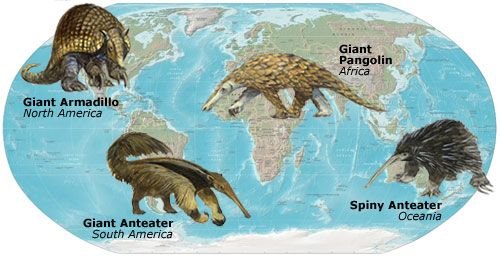
So, what makes the anteater so special? These creatures belong to the order Pilosa, which they share with sloths. Think of it like being part of an exclusive club with just a couple of unique members! Anteaters have adapted to their environment in remarkable ways, helping them thrive in places like the forests and grasslands of Central and South America. Let’s dive into the evolutionary history of the anteater and explore how they’ve become the fascinating animals we know today.
What Are Anteaters?
Anteaters are remarkable by design. They’re primarily known for their elongated snouts, which house a long tongue that can reach up to 16 inches! This tongue is specially adapted for slurping up ants and termites. But did you know that there are four species of anteaters? These include the giant anteater, the silky anteater, the Northern tamandua, and the Southern tamandua. Each species has its own unique traits, but they all share the common goal of digging into anthills.
In terms of size, the giant anteater is the largest, growing up to 7 feet long from snout to tail. That’s about the length of a small kid! On the other hand, the silky anteater is much smaller and has a more agile build. Imagine these different anteaters navigating their habitats, each equipped with their own set of skills.
Anteaters are fascinating not just because of their appearance but also due to their specialized diet. Their bodies are designed to handle a diet primarily made up of ants and termites. They lack teeth, which might sound odd, but it turns out they don’t need them! Their strong stomachs do the heavy lifting of grinding up their food.
The Anteater’s Ancient Ancestors
To understand the anteater’s evolutionary history, we have to rewind the clock a bit. The ancestors of modern anteaters appeared around 60 million years ago! These early relatives were quite different from the anteaters we see today. They belonged to a group called the Xenarthra, which includes not only anteaters but also sloths and armadillos.
These ancient ancestors roamed a variety of environments, adapting over time. Some were much larger than today’s anteaters. For instance, the giant anteater’s ancestor, known as the *Megalotherium*, was a massive creature that lived in South America during the Pleistocene epoch. Imagine a gigantic version of today’s anteater, wandering through lush landscapes!
As the climate changed and various ecosystems evolved, so did anteaters. They developed traits that helped them thrive in specific environments. For example, their long snouts and tongues were perfect for accessing hard-to-reach insects hiding in trees or underground.
Adaptations for Survival
Anteaters are like living examples of evolution in action. Their bodies have adapted specifically for their diet and lifestyle. One of the main adaptations is their keen sense of smell. Anteaters can sniff out ants and termites from a considerable distance. This ability is crucial, especially when considering their favorite meal might be hiding under dirt or in logs.
Another fascinating adaptation is their powerful front claws. These claws aren’t just for show; they’re essential tools for digging into ant mounds and tearing apart rotting logs to find food. When an anteater digs, it can move soil as if it’s using a mini shovel!
Moreover, anteaters have a unique way of life. They tend to be solitary and spend most of their time foraging. With a lifestyle that’s relatively quiet and low-energy, they’re designed to conserve energy for long days of searching for food. It’s a smart strategy that allows them to thrive in environments where food sources might be scarce.
Risks and Conservation Efforts
While anteaters are incredibly adapted to their environments, they face significant threats today. Habitat destruction due to deforestation and agriculture poses serious risks. As their natural homes shrink, anteaters struggle to find food and shelter.
Additionally, they face threats from poaching and road accidents. Often, they wander onto roads while searching for food, which can lead to fatal encounters with vehicles. Honestly, it’s a harsh reality for these creatures that have survived through millions of years of evolution.
Conservation efforts are critical to ensure the survival of anteaters. Organizations worldwide are working to protect their habitats and raise awareness about their plight. Educating communities about these unique animals can go a long way. It’s essential to promote coexistence strategies that reduce human-wildlife conflict and support ecosystem balance.
The Future of Anteaters
As we look ahead, it’s vital to remain optimistic about the anteater’s future. Conservationists are making strides in protecting their habitats and raising awareness. You might be wondering, how can we help? Simple actions like supporting wildlife organizations, reducing deforestation, and spreading the word about these fascinating creatures can contribute to their survival.
Moreover, researchers are continually studying anteater behavior and ecology. This research not only increases understanding but also helps develop effective conservation strategies. By learning more about these remarkable animals and their needs, we can help ensure they thrive for generations to come.
The anteater’s evolutionary history is a testament to resilience and adaptation. Their incredible journey from ancient ancestors to the clever creatures we see today is a story worth sharing and preserving. So, next time you see an anteater, remember the remarkable journey it represents—one that highlights the beauty of evolution and the importance of conservation.
In conclusion, the anteater’s evolutionary history is a captivating tale. From their ancient ancestors to today’s unique adaptations, these animals have shared an incredible journey. As we continue to support their conservation, we celebrate not just their history, but also their future. Just like that cup of coffee shared with a friend, let’s savor this story—because it’s one that deserves to be remembered.
